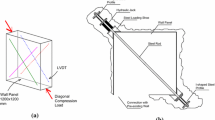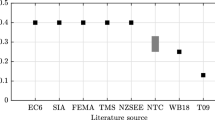Abstract
Many older unreinforced masonry (URM) buildings feature timber floors and solid brick masonry. Simple equivalent frame models can help predicting the expected failure mechanism and estimating the strength of a URM wall. When modelling a URM wall with an equivalent frame model rather than, for example, a more detailed simplified micro-model, the strengths of the piers and spandrels need to be estimated from mechanical or empirical models. Such models are readily available for URM piers, which have been tested in many different configurations. On the contrary, only few models for spandrel strength have been developed. This paper reviews these models, discusses their merits, faults and compares the predicted strength values to the results of recent experimental tests on masonry spandrels. Based on this assessment, the paper outlines recommendations for a new set of strength equations for masonry spandrels.
Similar content being viewed by others
References
Amadio G, Rinaldin G, Macorini L (2011) An equivalent frame model for nonlinear analysis of reinforced masonry buildings under in-plane cyclic loading. In: Proceedings of the ANIDIS 2011 convention on seismic engineering, Sep 18–22, 2011. Bari, Italy
ATC: (1998) FEMA-306 Evaluation of earthquake damaged concrete and masonry wall buildings. Basic Procedures Manual, Applied Technology Council, Washington DC
Augenti N, Parisi F, Prota A, Manfredi G (2011) In-plane lateral response of a full-scale masonry subassemblage with and without an inorganic matrix-grid strengthening system. J Comp Constr 15(4): 548–590
Belmouden Y, Lestuzzi P (2009) An equivalent frame model for seismic analysis of masonry and reinforced concrete buildings. Constr Build Mater 23(1): 40–53
Benedetti D, Carydis P, Pezzoli P (1998) Shaking table tests on 24 simple masonry buildings. Earthq Eng Struct Dyn 27(1): 67–90
Benedetti D, Carydis P, Limongelli MP (2001) Evaluation of the seismic response of masonry buildings based on energy functions. Earthq Eng Struct Dyn 30(7): 1061–1081
Braga F, Liberatore D (1990) A finite element for the analysis of the response of masonry buildings. In: Proceedings of 5th North American masonry conference, June 3–6, 1990. Urbana-Champaign, USA
Betti M, Galano L, Vignoli A (2008) Seismic response of masonry plane walls: A numerical study on spandrel strength. In: Proceedings of the 2008 seismic engineering conference commemorating the 1908 Messina and Reggio Calabria earthquake, AIP conference proceedings, July 8–11, 2008. Reggio Calabria, Italy
Beyer K and Dazio A (2012a) Quasi-static cyclic tests on masonry spandrels. Accepted for publication in Earthq Spectra (article available on http://eesd.epfl.ch/page-18604-en.html)
Beyer K and Dazio A (2012b) Quasi-static monotonic and cyclic tests on composite spandrels. Accepted for publication in Earthq Spectra (article available on http://eesd.epfl.ch/page-18604-en.html)
Calderoni B, Cordasco EA, Guerriero L, Lenz P (2008) Experimental analyses of yellow tuff spandrels of postmedieval buildings in the Naples area. In: Proceedings of the 2008 seismic engineering conference commemorating the 1908 Messina and Reggio Calabria earthquake, AIP conference proceedings, July 8–11, 2008. Reggio Calabria, Italy
Cattari S (2007) Modellazione a telaio equivalente di strutture esistenti in muratura e miste muratura-c.a.formulazione di modelli sintetici. Doctoral Thesis (in Italian), University of Genoa, Italy
Cattari S, Lagomarsino S (2008) A strength criterion for the flexural behaviour of spandrels in un-reinforced masonry walls. In: Proceedings of the 14th world conference on earthquake engineering, Oct 12–17, 2008. Beijing, China
CEN (2004) Eurocode 8 Design of structures for earthquake resistance—Part 1: General rules, seismic actions and rules for buildings, EN 1998-1:2004, European Committee for Standardisation, Brussels, Belgium
CEN (2005) Eurocode 6 Design of masonry structures—Part 1-1: General rules for reinforced and unreinforced masonry structures, EN 1996-1:2005, European Committee for Standardisation, Brussels, Belgium
CEN (2005) Eurocode 8 Design of structures for earthquake resistance—Part 3: General rules, seismic actions and rules for buildings, EN 1998-3:2005, European Committee for Standardisation, Brussels, Belgium
Chen SY, Moon FL, Yi T (2008) A macroelement for the nonlinear analysis of in-plane unreinforced masonry piers. Eng Struct 20(8): 2242–2252
CSA: (2004) Design of masonry structures S304.1. Canadian Standards Association, Ontario, Canada
Foraboschi P (2009) Coupling effect between masonry spandrels and piers. Mater Struct 42(3): 279–300
Gambarotta L, Lagomarsino S (1997) Damage models for the seismic response of brick masonry shear walls, Part II: the continuum model and its applications. Earthq Eng Struct Dyn 26(4): 441–462
Gattesco N, Clemente I, Macorini L, Noè S (2008) Experimental investigation of the behaviour of spandrels in ancient masonry buildings. In: Proceedings of the 14th world conference on earthquake engineering, Oct 12–17, 2008. Beijing, China
Graziotti F, Magenes G, Penna A (2009) Progetto di una sperimentazione su elementi di fascia muraria, Rapporto Reluis (in Italian). Allegato 4.3-UR01-1, Università di Pavia e EUCENTRE, Pavia, Italy
Haach GV, Vasconcelos G, Lourenço PB (2012) Experimental analysis of reinforced concrete block masonry spandrels using pre-fabricated planar trussed bars. Constr Build Mater 26(1): 156–166
Lagomarsino S, Penna A, Galasco A (2006) TREMURI program: seismic analysis program for 3D masonry buildings. Theory and user manual. University of Genoa, Genoa
Lourenço PB (1996) Computational strategies for masonry structures. Doctoral Thesis, Technical University Delft, The Netherlands
Magenes G (2000) A method for pushover analysis in seismic assessment of masonry buildings. In: Proceedings of the 12th world conference on earthquake engineering, Jan 30–Feb 4, 2000. Auckland, New Zealand
Magenes G, Calvi GM (1997) In-plane seismic response of brick masonry walls. Earthq Eng Struct Dyn 26(11): 1091–1112
Magenes G, Della Fontana A (1998) Simplified non-linear seismic analysis of masonry buildings. In: Proceedings of the British masonry society, Oct 13–15, 1998. London, UK
Magenes G, Menon A (2009) A review of the current status of seismic design and assessment of masonry buildings in Europe. J Struct Eng SERC Chennai 35(6): 247–256
Magenes G, Kingsley GR, Calvi GM (1995) Seismic testing of a full-scale, two-story masonry building: Test procedure and measured experimental response. Experimental and numerical investigation on a brick masonry building prototype Rep. No. 3.0, Gruppo Nazionale La Difesa Dai Terremoti, University of Pavia, Pavia, Italy
Magenes G, Morandi P, Manzini C, Morandi O, Bolognini D (2006) SAM II—Software for the simplified analysis of masonry buildings. Theory and user manual. University of Pavia and EUCENTRE, Pavia
Mallardo V, Malvezzi R, Milani E, Milani G (2008) Seismic vulnerability of historical masonry buildings: a case study in Ferrara. Eng Struct 30(8): 2223–2241
Mann W, Müller H (1982) Failure of shear-stressed masonry—An enlarged theory, tests and application to shear walls. In: Proceedings of the British ceramic society vol 30, pp 223–235
Milani G, Beyer K, Dazio A (2009) Upper bound analysis of meso-mechanical spandrel models for the pushover analysis of 2D masonry frames. Eng Struct 31(7): 2696–2710
NZSEE (2011a) Assessment and improvement of unreinforced masonry buildings for earthquake resistance. Draft guideline, New Zealand Society for Earthquake Engineering, Wellington, New Zealand
NZSEE (2011b) Commentary to assessment and improvement of unreinforced masonry buildings for earthquake resistance. Draft commentary, New Zealand Society for Earthquake Engineering, Wellington, New Zealand
OPCM (2003) OPCM 3274—Primi elementi in materia di criteri generali per la classificazione sismica del territorio nazionale e di normative tecniche per le costruzioni in zona sismica, 20/03/2003 (in Italian)
OPCM (2005) OPCM 3431—Ulteriori modifiche ed integrazioni all OPCM 3274/03, 09/05/2005 (in Italian)
Parisi F, Augenti N (2011) Evolutionary strength domains of unreinforced masonry spandrel panels including strain softening. In: Proceedings of the 9th Pacific conference on earthquake engineering, April 14–16, 2011. Auckland, New Zealand
Pasticier L, Amadio C, Fragiacomo M (2008) Non-linear seismic analysis and vulnerability evaluation of a masonry building by means of the SAP2000 V.10 code. Earthq Eng Struct Dyn 37(3): 467–485
Penna A (2010) Tools and strategies for the performance-based seismic assessment of masonry buildings. In: Proceedings of the international workshop on protection of built environment against earthquakes, Aug 27–28, 2010. Ljubljana, Slovenia
Rots JG and Lourenço PB (1993) Fracture simulations of masonry using non-linear interface elements. In: Proceedings of the 6th North American masonry conference, Philadelphia, USA
Sabatino R and Rizzano G (2011) A simplified approach for the seismic analysis of masonry structures. The Open Construction and Build. Technol J 5(Suppl. 1-M7):97–104
SAI: (1998) Strengthening existing buildings for earthquake (AS 3826). Standards Australia International, Sydney
SAI: (2001) Masonry Structures (AS 3700). Standards Australia International, Sydney
Salonikios T, Karakostas C, Lekidis V, Anthoine A (2003) Comparative inelastic pushover analysis of masonry frames. Eng Struct 25(12): 1515–1523
Tomaževič M (1987) Dynamic modelling of masonry buildings: storey mechanism model as a simple alternative. Earthq Eng Struct Dyn 15(6): 731–749
Turnšek V, Čačovič F (1970) Some experimental results on the strength of brick masonry walls. In: Proceedings of the 2nd international brick masonry conference, Stoke on Trent, United Kingdom, pp 149–156
Yi T, Moon FL, Leon RT, Kahn LF (2006) Lateral load tests on a two-story unreinforced masonry building. J Struct Eng ASCE 132(5): 652–653
Author information
Authors and Affiliations
Corresponding author
Rights and permissions
About this article
Cite this article
Beyer, K., Mangalathu, S. Review of strength models for masonry spandrels. Bull Earthquake Eng 11, 521–542 (2013). https://doi.org/10.1007/s10518-012-9394-3
Received:
Accepted:
Published:
Issue Date:
DOI: https://doi.org/10.1007/s10518-012-9394-3




